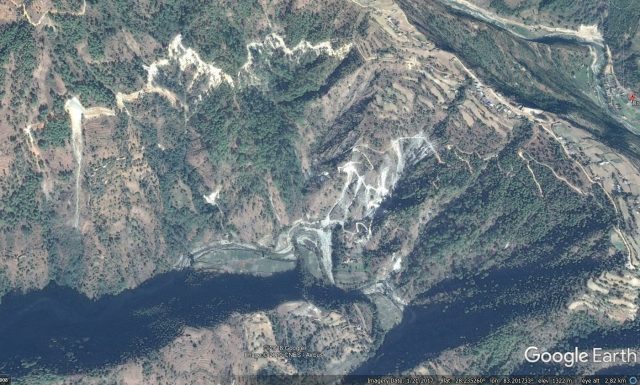3 September 2019
The tyranny of dozer road building
Posted by Dave Petley
The tyranny of dozer road building
As the 2019 summer monsoon starts to wind down across Nepal, two newspapers have published well-considered articles examining the disastrous effects of so-called dozer roads. These are new roads, built in rural areas, with the use of bulldozers but essentially no engineering. One article, by Dane Carlson in The Himalayan Times, provides a greater articulation of the problem:
“Dozer road building usually comes along with a near-total absence of proper drainage, haphazard destruction of wide swathes of vegetation, and reckless downhill soil dumping. This is a human and environmental disaster underway in plain sight. The current upward trend in dozer road building across the country indicates the steady, if not exponential, growth of this disaster.”
The same article describes the conundrum:
“Road building is now ubiquitous across Nepal, from Kathmandu to the most remote corners of the country. Every Nepali deserves access to a road and the vital services that come with it: education, medicine, access to new markets, and easy transport to urban centres. Road building and maintenance bring paid work, especially needed in remote communities. Nobody would argue against the importance of these outcomes.
“But roads aren’t the development cure-all that many pretend they are. Just as ubiquitous as road building in Nepal is the destruction that accompanies it: if you’re travelling in the hills and want to find a road, just look for the landslides. The vast majority of Nepal’s local road network is cut haphazardly into steep hillsides with little or no planning, triggering landslides and washing massive amounts of soil into rivers.”
The practice of dozer road building is widespread and massively destructive. Astonishingly, the article notes that “from 1998 to 2016, the length of Nepal’s road network multiplied by a factor of 11“.
Meanwhile, The Kathmandu Post describes the effects of this blizzard of road building in one district, Baglung:-
“In Baglung Municipality too roads get swept away every year by landslides. Gyanendra Gautam, ward chairman of Baglung Ward No 11, said that most of the rural roads have been swept away by landslides in this monsoon. “Forget vehicles, even people can’t walk through these rural roads,” said Gautam.”
I have written previously about the disastrous effects of these dozer roads in Nepal. The Google Earth image below, from Badigad in Nepal, shows the scale of the problem:-

A Google Earth image from Badigad in Baglung, Nepal, showing the scale of landslides associated with Dozer roads
.
This pattern is repeated endlessly across the Hill Districts of Nepal, and the problem is getting worse, quickly. The irony is of course that in many cases, the local population ends up being worse off a few years after the road has been built. As Dale Carson writes:
“Roads and the services they provide are needed. But the current trajectory of road building trades short-term benefits for widespread long-term problems. And, like many disasters, these will be driven by the actions of the wealthy and powerful few to the detriment of the many.”
This is an avoidable environmental and human tragedy.


 Dave Petley is the Vice-Chancellor of the University of Hull in the United Kingdom. His blog provides commentary and analysis of landslide events occurring worldwide, including the landslides themselves, latest research, and conferences and meetings.
Dave Petley is the Vice-Chancellor of the University of Hull in the United Kingdom. His blog provides commentary and analysis of landslide events occurring worldwide, including the landslides themselves, latest research, and conferences and meetings.
Es como si hubiera escrito un articulo de la realidad en Colombia, la historia se repite en nuestro país, las vías terciarias se abren por la experiencia del operador de la maquina (poca ingeniería), no se considera las obras hidráulicas que protegen la carretera, igualmente el bombeo de las vías es inexistente; mientras las autoridades municipales y ambientales no alcanzan a ejercer control sobre la disposición final de los materiales cortados.
Este tipo de intervenciones aceleran procesos erosivos y de inestabilidad en suelos residuales profundos, se aumenta la susceptibilidad a deslizamientos de mayor tamaño.
[Many, many thanks. Rough translation: It is as if I had written an article about the reality in Colombia, history repeats itself in our country, tertiary roads are opened using the experience of the machine operator (with little engineering), the hydraulic works that protect the road are not considered, also the pumping of the tracks is non-existent; while municipal and environmental authorities fail to exercise control over the final disposal of cut materials.
This type of intervention accelerates erosion and instability processes in deep residual soils, the susceptibility to larger landslides is increased. D.]
The problem seems very similar to the effects of forestry roads in the mountainous parts of British Columbia. Here we have similar issues of unengineered roads built with little more than a bulldozer in steep terrain, and similar results of significantly increased landslide hazards. The problem is exacerbated by the fact that for forestry operations the roads typically are only needed for less than five years, so to the forestry companies it doesn’t matter from an operations perspective if they subsequently fail. Conversely, that can be helpful as the roads can be deactivated and somewhat reclaimed after use, before the road has had an opportunity to fail.